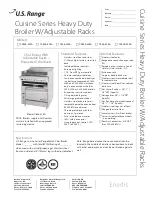
WARNING
ELECTRICAL GROUNDING INSTRUCTIONS Rotisserie Motor
-This appliance is equipped with a plug and should be
plugged directly into a properly grounded receptacle. When installed, must be electrically grounded in accordance with local
codes or in the absence of local codes, with the National Electrical Code, ANSI/NFPA 70 or the Canadian Electrical Code,
CSA C22.1 DO NOT cut or remove the grounding prong from this plug.
1.
To protect against electric shock, do not immerse cord or plugs in water or other liquid.
2.
Unplug from the outlet when not in use and before cleaning. Allow to cool before putting on or taking off parts.
3.
Do not operate any outdoor cooking gas appliance with a damaged cord, plug, or after the appliance malfunctions or
has been damaged in any manner. Contact the manufacturer for repair.
4.
Do not let the cord hang over the edge of a table of touch hot surface.
5.
Do not use an outdoor cooking gas appliance for purposes other than intended.
6.
When connecting, first connect plug to the outdoor cooking gas appliance then plug appliance into the outlet.
7.
Use only a Ground Fault Interrupt (GFI) protected circuit with this outdoor cooking gas appliance.
8.
Never remove the grounding plug or use with an adapter of 2 prongs.
9.
Use only extension cords with a 3 prong grounding plug, rated for the power of the equipments, and approved for
outdoor use with a W-A marking.
Safety Instruction
WARNING
Do not try lighting this appliance without reading the
“LIGHTING INSTRUCTIONS” section of this manual.
CAUTION: Beware of Flashback
TESTED IN ACCORDANCE WITH ANS Z21.58a CSA
1.6a-2008 STANDARD FOR OUTDOOR COOKING GAS
APPLIANCE. THIS GRILL IS FOR OUTDOOR USE ONLY.
CAUTION:
Spiders and small insects occasionally
spin webs or make nests in the grill
burner tubes during transit and
warehousing. These webs can lead
to gas flow obstruction, which could
result in a fire in and around burner
tubes. This type of fire is known as
“FLASH-BACK,” and can cause serious damage to your grill
and create an unsafe operating condition for the user.
Grill Installation Codes
Check your local building codes for the proper method of
and create an unsafe operating condition for the user.
Although an obstructed burner tube is not the only cause of
“FLASH-BACK,” it is the most common cause.
To reduce the chance of “FLASH-BACK,” you must clean the
burner tubes before assembling your grill, and at least once a
month in late summer or early fall when spiders are most
active. Also perform this burner tube cleaning procedure if
your grill has not been used for an extended period of time. A
clogged tube can be lead to a fire beneath the grill.
Check your local building codes for the proper method of
installation. In the absence of local codes, this unit should
be installed in accordance with the National Fuel Gas
Code,ANSI Z223.1/NFPA 54,Storage and Handling of
Liquefied Petroleum Gases, ANSI /NFPA B149.2 or CSA
B149.1 Natural Gas and Propane Installation Code, and the
National Electrical Code, ANSI/NFPA 70.
Correct LP Gas Tank Use
LP gas grill models are designed for use with a standard 20
lb (9 kg). Liquid Propane Gas tank, not included with grill.
Never
connect your gas grill to an LP gas tank that
exceeds this capacity.
If an external electrical source is utilized
: The outdoor
cooking gas appliance, when installed, must be electrically
grounded in accordance with local codes or, in the absence
of local codes, with the National Electrical Code,
ANSI/NFPA 70, or the Canadian Electrical Code, CSA
C22.1.
WARNING
Keep any electrical supply cord and the fuel supply hose
away from any heated surfaces.
NOTE
: The normal flow of gas through the regulator and
hose assembly can create a humming noise. A low volume
of noise is perfectly normal and will not interfere with
operation of the grill. If humming noise is loud and
excessive you may need to purge air from the gas line or
reset the regulator excess gas flow device. This purging
procedure should be done every time a new LP gas tank is
connected to your grill.
Visually check the burner flames prior to each use. The
flames should look like this picture. If they do not, refer to the
burner maintenance part of this manual.
4





































